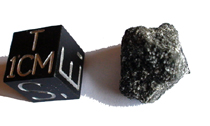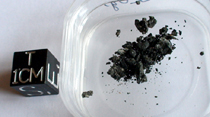CI Group
Chondrites of the CI group are named for their type specimen Ivuna,
which fell in Tanzania in 1938, and there are only a handful of those rare
meteorites known. The CI chondrites represent some of the most primitive,
friable, and "ugly" meteorites - and yet they are some of the
most interesting ones.
They all belong to the petrologic type 1, which means that they
suffered a large degree of aqueous alteration. Hence they don't contain
any relict chondrules but instead, a large amount of water, up to 20%, in
addition to lots of minerals that have been altered in the presence of
water such as hydrous phyllosilicates similar to terrestrial clays,
oxidized iron in the form of magnetite, and sparsely distributed crystals
of olivine scattered throughout the black matrix. In addition, they
contain certain amounts of organic matter like PAHs and amino acids, which
are the building blocks of life on earth. Because of that peculiar mixture
of water and complex organic compounds the chondrites of the CI group are
suspected to contain fascinating clues to the origin of life on our planet
and maybe elsewhere in the universe too!
Some researchers suggest the origin of the CI chondrites is from comets
that are known to be "dirty snowballs" - a mixture of frozen
water and pristine matter. Even if that isn't true, the origin of the CI
chondrites is certainly in the outer reaches of our solar system since
they never have been heated above 50°C during their formation and their
subsequent history. Otherwise, the water would have evaporated quite
rapidly and the hydrous phyllosilicates would have been metamorphosed into
other minerals due to the loss of water.
|
Ivuna December 16, 1938 in Tanzania
TKW 705 gr
CI1
Type specimen Witnessed fall !
|
 
|
|
|
|
Ivuna -00
very large chunky specimen
2.75 gr !!!!!!!
SOLD
|
|
|
|
|
|
|
|
Ivuna -01
big interior fragment
SOLD
|
|
|
|
 
|
|
|
|
|
|
|
 
|
|
|
|
Ivuna -03
fragment
0.128gr
SOLD
|
|
|
|
|
|
|
|
Ivuna -04
many fragments from this rare Ci1
0.220gr
SOLD
|
|
|
|
 
|
|
|
|
|
|
|
|
|
|
|
|
|
|
|
|
|
|
|
|